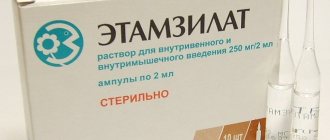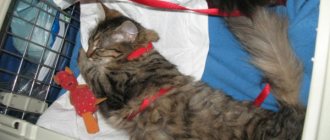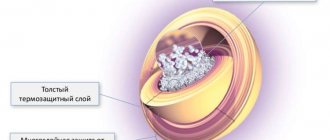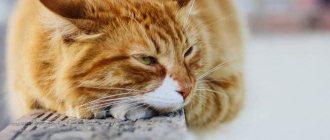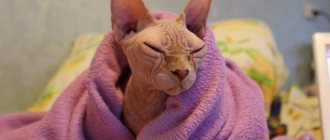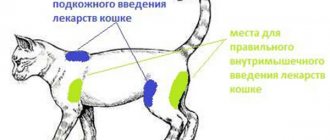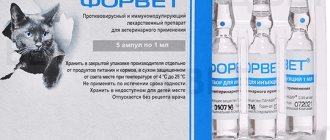The vibration of the walls of the arteries, which is caused by the work of the heart muscle, is called the pulse. It is felt as a slight shock, and their number indicates the state of health of the animal. Knowing the norms of this indicator in a cat and the method of measuring it is one of the important skills of every owner of these furry pets. Based on the data obtained, pathologies can be identified and treated in a timely manner.
How to measure correctly?
It is better to take measurements if the cat is in a calm state, when the heart is not beating very quickly, in which case the indicators will be more accurate. To feel the pulsation, you need to place your palm on the cat's inner thigh, at the point where the body and limb meet. The kicks should be strong and rhythmic, they can also be felt well on the inside of the animal’s shoulder and on the chest. By placing your hand on the chest, you can feel the heartbeat, the number of beats per minute will be the desired indicator. You should not press very hard on your pet's body, but firmly.
It is not recommended to measure the pulse with your thumb, as this way it is easy to confuse the cat's heartbeat with your own.
Methods for measuring heart rate in cats
Sometimes, in order not to miss any disease in your pet, it is enough to simply measure its pulse in time. Let's look at how this is done. We humans, when we want to count our heart rate, we squeeze the wrist area. Where is a cat's pulse? The easiest way for an animal to feel the pulsation of the large femoral artery is to press on the inside of the thigh (in the groin, where the cat's leg connects to the body). But here we note that some wayward pets may simply not allow the owner to touch the groin area. Otherwise, the pulse of a cat, cat or kitten can be measured by pressing the palm of your hand on the area of the sternum on the left side (where you can feel the heart beats).
The cat's pulse rate is usually measured over 1 minute. But what if the cat is indignant (breaks out, tries to bite, hisses, etc.)? Measurement time can be halved or quadrupled. For an aggressive pet, the measurement time can be reduced to 15 seconds, and then simply multiply the resulting value by 4 (the result of a 30-second measurement must be increased by 2).
When figuring out what your cat's heart rate is, it's important to keep these things in mind:
- Pulse counting should be done when the animal is as calm as possible. An excited cat's pulse is always significantly higher than normal;
During the measurement, the owner should under no circumstances shout at the cat, hit or squeeze it forcefully. This will cause the pulse of the unnerved animal to jump up;
You should not take the pulse of a sleeping pet. During sleep, cats' heart rate is lower than when awake;
- There is no need to put too much pressure on the cat's groin or chest. With strong pressure, it is difficult to calculate the pulse rate correctly.
Characteristics
The ability to control the condition of your pets can save their lives.
An owner who has knowledge of the pulse of kittens and big cats will be able to promptly notify the veterinarian about problems with the pet’s health. The pulse of cats and cats has the following characteristics:
- Filling is the volume of blood in the vessels at the highest point of pulsation.
- Tension is the amount of force applied when squeezing an artery.
- Frequency - how many times the heart contracts (beats) per minute.
- Shape—the rate of change in arterial volume.
- Height is the range of vibration of the vessel wall.
- Rhythm - the interval between shocks.
First aid
If an animal has choked on an object, you can try to get it out.
If a foreign object is suspected of entering the respiratory tract, the cat's jaw opens as much as possible. In this position, the owner needs to pick up the hard piece that is clogging the throat with his hands or tweezers. If you cannot get the object, then the animal must be turned upside down, tightly grasping its hind legs. With the other hand, press firmly, at intervals, on the tummy under the diaphragm. With this stimulation, the cat will be able to spit out the object.
If you suspect a heart attack, which can be determined by a change in pulse and cyanosis, the animal must be urgently taken to a veterinarian so that he can give an injection of medication. If a cat stops breathing, it needs to be resuscitated at home and then taken to the hospital. The algorithm of actions is as follows:
- The pet is placed on a table or floor so that the vertebrae are in line.
- Use cotton wool or a paper towel to remove discharge from the mouth.
- The jaws are clamped with one palm, and the second is rolled up into a tube in front of the muzzle. Powerful exhalations into the animal’s nose are shown at intervals of 2 seconds.
- If the heart does not beat, you need to start pressing rhythmically on the sternum.
Veterinarians note that with properly performed resuscitation, cats regain consciousness within 7-15 minutes.
Reasons for changes
An indicator of health is a moderate pulsation value. Changes in heart rate can be normal, for example, it increases during sexual activity, after active running, playing and in a state of anxiety, and slows down when the cat is sleeping or just woke up. In the same way, changes can be considered as symptoms of pathological processes in the body.
Symptoms of defects
| Characteristic | Heart rate indicator | Pathology |
| Filling | Full | Hypertension |
| Empty | Hypotension | |
| Loss of consciousness | ||
| Dehydration | ||
| Very weak | Comatosis | |
| Major blood loss | ||
| Shock | ||
| Collapse | ||
| Voltage | Solid | Risk of stroke or heart attack (with high blood pressure) |
| Soft | Dehydration | |
| Blood loss | ||
| Decreased tone of vascular walls (with low blood pressure) | ||
| Frequency | Frequent (tachycardia in cats) | Anemia |
| Heatstroke | ||
| Endocrine system disease | ||
| Dehydration | ||
| Infections (accompanied by elevated body temperature) | ||
| Rare (bradycardia) | Cardiovascular diseases | |
| Form | Fast (at maximum blood pressure drop) | Insufficiency of the aortic valve apparatus |
| Anemia | ||
| Slow (with minimal blood pressure drop) | Narrowing of the aortic ostium | |
| Double/double-humped (when blood hits a closed valve) | Severe cardiomyopathy (accompanied by fever) | |
| Height | Big | Pathologies of the endocrine system |
| Aortic insufficiency | ||
| Small | Heart failure | |
| Aortic stenosis | ||
| Rhythm | Rhythmic | – |
| Arrhythmic | Tachycardia and bradycardia are a signal of pathology and heart defects |
How to measure a cat's pulse
- Adult cat or kitten
- British brindle cat
- Organization of control of intestinal parasites in the nursery
- The relationship of a cat to a person
- Poisonous plants for cats and other dangers
- Stopping bleeding in cats
- Accessories for cats in the nursery
- Complete nutrition for cats
- When kittens start walking: transition period and socialization
- Blue Eyes
- Puberty in cats.
- Blood types in cats
- Caring for your cat before shows and during normal times
Normalization of pulse and treatment
Changes in heart rate are not always symptoms of deteriorating animal health. After active movements and games, the heartbeat is frequent and strong, and accordingly the pulse accelerates; this should not frighten the owner; he will soon return to normal. But veterinarians warn that if the pulse changes and weakness, fainting appears, breathing becomes impaired, the color of the mucous membranes changes towards white or bluish, then these are alarming symptoms. The cat must be taken to the doctor immediately, as the pet requires treatment.
The cat's pulse is below normal
Tachycardia or rapid pulse is a dangerous disease. What if the cat’s pulse is below normal? This is also bad: bradycardia (low pulse) leads to severe weakness, the formation of blood clots, with this disease the internal organs are poorly supplied with blood and quickly fail. In addition, this is also dangerous, since with bradycardia, animals often lose consciousness.
Sometimes bradycardia is accompanied only by weakness, but in advanced cases the following symptoms may be present:
- Impaired coordination of movements (the cat has a “drunk” gait);
Jumps in blood pressure (normally, a cat’s blood pressure ranges from 105/65 to 135/95 mm Hg);
Bradycardia in a cat is not an independent disease. This is a symptom of other serious illnesses:
- Poisoning (insect and snake poisons, lead, pesticides, etc.);
Heart problems (myocarditis, cardiomyopathy, aortic stenosis, etc.);
Sepsis in infectious diseases or as a complication after surgery;
High intracranial pressure due to traumatic brain injury and brain diseases (meningoencephalitis, meningitis, epilepsy, etc.);
It is possible to rid a cat of bradycardia if the cause of the low pulse is determined. To make a correct diagnosis, the doctor will prescribe urine and blood tests, as well as important studies: ultrasound and x-ray of the heart, as well as an electrocardiogram.
Anatomy of cats
The body of a domestic cat is divided into conventional anatomical regions and parts. Body parts: neck, head, torso, limbs and tail.
The head is divided into a muzzle and a skull. The muzzle contains the nasal, buccal, oral, orbital and premaxillary regions. The anterior upper part of the head, temples, forehead, crown and back of the head are distinguished on the skull.
The body is divided into the chest, back and chest with mammary glands. The abdomen is divided into anterior, posterior and middle regions. The limbs are divided into thoracic and pelvic.
The cat skeleton consists of 240 bones of different sizes and shapes. Together with the skin and muscles, the skeleton determines the outline of the body.
There are retractable claws on the fingers. The cat steps on the pads. The pads with the toes are called the tarsus.
The muscles of the body, head, neck and limbs create a single muscular system that controls the movements of the animal.
The nervous system consists of the spinal cord, brain, and nerve trunks. The activity of the nervous system is carried out using the senses: hearing, vision, smell, taste and touch.
Eyes of a healthy and sick cat
A healthy animal's coat looks neat, has a healthy shine and gloss, regardless of length. When a cat is sick, the coat becomes dull, tousled, hair loss is observed, and a change in the color of the coat is possible, as well as a decrease in the elasticity of the skin.
Another way to check if the body is dehydrated is to grab the cat by the withers and let go. If the skin quickly returns to its place and the fur settles down, the body is not so dehydrated as to consider the condition critical. If the skin does not return quickly, immediately take the cat to the car and to the veterinarian’s office, or, if possible, urgently call a veterinarian to your home. This is quite a serious problem when minutes are critical.
The nose, or nasal planum, is usually moist and cold. As the temperature rises, the nose becomes dry and constantly warm, and the skin may begin to crack. Mucopurulent discharge from the nostrils, the formation of dry crusts, and a whitened earlobe (a sign of anemia) are sure signs of a cat’s illness. With anemia, the earlobe may turn white, and with viral diseases or colds, purulent or mucous discharge from one or both nostrils, as well as peeling in the form of dry crusts, may be observed.
The eyes of a healthy cat are: completely open, clear, shiny; the whites are white, the eyelids are without swelling or redness, there is no discharge (a slight discharge of brown exudate is the norm, especially in flat-faced cats: British, Persian, etc.).
A sick cat may experience various discharges from the eyes (clear, purulent, mucous, etc.). Watery eyes and squinting may indicate pain in the eye or eyes; yellowness of the mucous membrane indicates problems with the liver; redness and inflammation of the eyelids may indicate fever and other disorders.
The oral cavity of a healthy cat: the gums and oral cavity are pink and smooth, the teeth are white, the smell from the mouth is neutral (a not too pleasant smell from the cat’s mouth immediately after she has eaten is normal).
An indicator of abnormal oral health is an unpleasant odor coming from the mouth, inflammation or ulcers on the gums, tongue and mucous membranes, and coating of the tongue. The mucous membranes of the mouth and eyelids are pale, bluish or icteric. Increased salivation can occur when there is damage to the mouth or tongue, as well as when a foreign body enters the esophagus.
It may also be a symptom of sunstroke or heatstroke, certain liver diseases, or poisoning. In addition, one should not forget about such a terrible disease as rabies - this is one of the main symptoms and if the cat is not vaccinated, it is necessary to urgently contact a veterinarian and take measures to prevent bites.
Yellowness of the mucous membranes may indicate suspicion of leptospirosis, hepatitis or severe poisoning.
Increased water consumption relative to normal, thirst, may be associated with kidney failure, diabetes, dropsy, colds or kidney disease. If in the complex there is rapid fatigue, weakness and bad breath from the cat, these are some of the most striking symptoms of uremia (also a reason for urgently seeking professional help).
Vomiting may occur as a reaction to poisons entering the stomach (poisonous herbs, household chemicals, etc.) and a general reaction to poisoning, as well as as a result of helminthic infestation or motion sickness. If vomiting is accompanied by increasing weakness of the cat in combination with constipation, this indicates intestinal obstruction, as well as the presence of a foreign body in the intestine. In most cases, this is an indication for urgent surgery.
Digestion of a healthy cat: stool 1-2 times a day, formed, without foreign inclusions, brown; if the cat is litter box trained, the discharge should only be in the tray. (mild and occasional vomiting is normal). The digestion of a sick cat may be impaired. If changes occur in the activity of the gastrointestinal tract, this may be expressed in the form of diarrhea or constipation, vomiting, accumulation of gas in the intestines and painful bowel movements, as well as a combination of several symptoms. It is possible that foreign objects may appear in the feces, such as wool, worms, and worm larvae.
Drops of blood may appear in the feces (usually they are brown), which indicates a serious pathology - bleeding in the large intestine. Tarry, almost black stool is a symptom of bleeding in the anterior intestine or gastric bleeding. A lack of bile, which is a sign of liver disease, is indicated by clarified feces. If your cat has foamy feces, this is, in most cases, a sign of a bacterial infection.
Genitourinary system of a healthy cat: no discharge (except for urine; pregnant cats may have discharge from the vulva, and many cats may have slight discharge of exudate), yellow urine without foreign inclusions, painless urination, urination 2-3 times a day.
The genitourinary system of cats can be susceptible to a number of diseases. Abnormalities in this area may include urinary incontinence, increased urination or lack of urination, and changes in the color of urine (in a healthy cat it has a yellow tint).
An increase in the size of the lymph nodes signals the development of an inflammatory process. Most often, the submandibular lymph nodes are involved in this process, so every cat owner needs to be able to find and feel them.
{amp}gt;The pose of a cat can tell you a lot. A healthy animal rests or sleeps in a relaxed position, with its torso straightened and limbs stretched out. A sick cat takes a forced position that helps reduce pain or any discomfort. In particular, with heart disease, a cat stands with its forelimbs spread wide apart - this makes breathing easier;
The above signs of diseases, as a rule, do not appear all at the same time: usually one sign is most pronounced, and the rest accompany it (in one combination or another). The improvement in the cat’s well-being and recovery can be judged after the disappearance of all painful manifestations characteristic of a particular disease.
If there is anything about your cat's physical condition or behavior that worries you, call your veterinarian at home or take your pet to the nearest veterinary clinic.
There is no such thing as a healthy cat having a high or low temperature, as well as abnormalities in pulse, respiratory rate or the condition of the mucous membranes. Changes in these indicators always indicate health problems.
What does a healthy cat look like?
- Excellent appetite.
- The cat is not disheveled, has smooth fur, and takes diligent care of its coat.
- The nose is cold and moist (during sleep it can be dry and warm).
- The mucous membranes are pink and moderately moist.
- The cat does not hide from you and does not seek privacy.
- Temperature, pulse and respiratory rate appropriate for a healthy cat.
- There are no deposits, inflammations or crusts around the eyes.
- The skin should be free of scabs, ulcers and other lesions, as well as tumors that can be detected by palpation
- The animal should not be emaciated - in this case, the cat's ribs protrude - or too fat, since obesity also negatively affects the general condition of the animal.
- A healthy animal's teeth are white and its gums are pink, although some breeds have dark-colored gums.
- A healthy cat, especially a young one, is quite playful, alert and active, it has a very quick reaction, even in a sleeping animal, since cats have very sensitive hearing.
- A pitiful meow, a wet cold nose or, conversely, too dry and hot.
- Lack of appetite, refusal of water. As a result, there is usually severe weight loss and dehydration.
- Anxiety, nervousness.
- Heavy shedding.
- Constantly hides in secluded places, despite the fact that you try to lure him out and pull him out.
- The cat sleeps excessively, longer than usual and mostly lies on the litter
- The cat does not groom itself, does not lick its fur, does not sharpen its claws.
- Does not show interest in the world around him, the cat does not show a desire to go outside, apathy towards everything, does not play, and is in a depressed mood.
- There is obvious lameness.
- Vomiting and diarrhea are observed.
- Prolapse of the third eyelid in cats.
- Breathing is difficult (rapid, with wheezing, whistling).
- The gums bleed, spots and rashes are observed.
- The cat constantly bites, licks, scratches, scratches any specific part of the body.
- The cat coughs and sneezes.
- There is discharge from the nose and eyes.
- Heavy salivation.
- The belly is unnaturally swollen.
- While eating, difficulties arise: the cat chokes on saliva or spits out food, food falls out of the mouth, the cat eats very little.
- There is swelling of the limbs or swelling of parts of the body.
We suggest you read: Quail maintenance and care on the balcony
However, all symptoms do not appear at once and they are not always pronounced. Most often, one of the signs is most pronounced, while others accompany it and can be combined in various variations. The degree of the painful condition, the recovery of the cat or the deterioration of the condition can be judged by the disappearance of painful manifestations or the intensification of symptoms that are characteristic of a given disease or complex of diseases.
A healthy cat's temperature is considered normal, ranging from 38°C to 39°C. Sphynx cats can have a temperature of up to 41.5°C, and small kittens can have a normal temperature of up to 39.6°C.
If your cat's temperature rises above 40°C, this may be a sign of the onset of a pathological process. Typically, the temperature reaction is an indicator of the body’s reactivity, or natural resistance (the body’s resistance or resistance to the effects of viruses and bacteria, that is, immunity), but a sharp increase to 41°C degrees is an indicator of the need for urgent medical attention and assistance.
A rise in temperature can be triggered by excitement or fear, in which case the temperature does not last long. In addition, a cat’s temperature can rise after physical exertion, in hot weather, as well as in case of poisoning or as a result of electric shock. High temperature can also be caused by such a phenomenon as hyperfunction of the thyroid gland.
Research by American scientists in 2001 (I. Calcagno) showed that the most common causes of a sharp rise in temperature (or fever) in 40% of cases are infectious diseases, systemic diseases and oncology occupy 20% in equal shares, other diseases and idiopathic fever accounts for 10%.
Your cat's normal temperature may differ from the average (just like in humans, 36.6°C is an average, not an individual). Therefore, it is recommended to measure the temperature of a healthy cat and record it. This measurement must be taken when the cat is in a good mood and at rest.
The measurement procedure is quite simple, but for cats that do not trust you or resist the procedure, you should first prepare a large towel or blanket for restraint. Your cat's first aid kit should have its own thermometer, since temperature is measured rectally. To measure with a regular mercury thermometer, prepare it for measurement according to the instructions (shaking it off several times), smear it with Vaseline or other fat and carefully, turning it slightly, insert it into the rectum 1.5-2 cm.
For the same purpose, you can use more modern electronic thermometers; the measurement is carried out using the same method according to the instructions for the thermometer.
The pulse reflects the frequency and rhythm of the heartbeat, as well as the force of the heart muscle impulses. At rest, the heart rate of a healthy cat ranges from 110 to 150 beats per minute. Large cats and animals that lead a quieter lifestyle have a slower heartbeat. The pulse increases when the temperature rises, during inflammatory processes, physical activity, overexcitation, fear and hot weather.
In kittens and cats of small breeds, the pulse rate can reach 200 beats per minute; in cats, the pulse is lower than in cats. Count and record your cat's resting heart rate - this will help you determine in the future whether its rate has changed in a given situation. It is enough to calculate the number of shocks in 15 seconds, and then multiply the resulting value by 4.
It is convenient to determine the cat's breathing rate by movements of the chest, abdominal wall or wings of the nose. Normally, it ranges from 20 to 30 respiratory movements per minute. Kittens and young animals, which have a more active metabolism than adults, breathe more quickly than adult cats, and females breathe more quickly than males.
Changes in your cat's breathing rate can be caused by fear, pain, shock, or respiratory illness. It should also be taken into account that breathing becomes more frequent in hot weather, during physical activity, and when the cat is excited. The breathing of a healthy animal after exercise is restored within a few minutes.
In a sick cat, breathing becomes frequent or, conversely, rare and cautious (if painful), wheezing, wheezing, coughing, and shortness of breath appear. Shortness of breath in a cat can be caused by increased physical activity, asthma, inflammation or emphysema, which, in turn, is a consequence of poisoning.
When do you need to see a doctor?
To accurately determine the causes of disorders, the veterinarian prescribes a biochemical blood test and ultrasound, and sometimes an additional X-ray examination is performed.
The owner should be wary if the pet begins to breathe from its stomach.
Heartbeat disturbances can be detected by abdominal breathing, in which the pet swells its sides. A slight excess of the norm does not indicate the need for immediate hospitalization, especially when exposed to external factors. However, if the following accompanying signs occur, the cat should be taken to the veterinarian:
- The heart rate is higher or lower than normal.
- The mucous membranes of the eyes or mouth have changed color to scarlet, whitish or blue.
- The appearance of gurgling sounds in the sternum area.
- Hoarseness, drainage of fluid from the nostrils or mouth.
An increase in this indicator is characteristic of an asthmatic attack in an animal.
- Infection. Cats experience bronchitis, colds, pneumonia, inflammation of the mucous membrane of the nose or trachea. Additional negative symptoms are mucus discharge from the nostrils, stinky mouth, cough and changes in body temperature. The increase in the number of breaths occurs due to the blockage of the airways by a large number of white blood cells, which creates immunity to fight infection.
- Asthmatic attack and allergic reactions. The pet breathes shallowly and coughs frequently.
- Malignant neoplasms. The cat family is susceptible to cancer. A tumor in the trachea, larynx or lung tissue makes it difficult for air to enter. With a constant lack of oxygen, the cat quickly weakens, refuses food and loses interest in life.
- Tear of the oral mucosa. Ulcers, wounds and fistulas cause severe pain when inhaled, so the animal tries to swallow more air at one time, but this provokes a malfunction and gives a backlash.
- Violation of the integrity of the ribs. If bone fragments put pressure on the respiratory organs, their functioning is disrupted. Damage can be detected by severe pain and intense abdominal movements during breathing.
- Entry of a foreign object. Your pet may choke on a bone, garbage, or hard food. Often a cat will clear its throat on its own, but if an object goes deep into the throat, the animal will need the help of a doctor.
- Pathologies of the heart or blood vessels. Associated negative symptoms are blue discoloration of the mucous membranes, white skin, apathy and wheezing in the sternum.
We suggest you read: Breeds of cats with ear defects
Heart rate indicators
The cat's normal heart rate is 100-130 beats per minute. If your pet is still young, then its bullets will be higher - up to 200 hits.
If your pet is overweight, it will be more difficult to find his pulse. During activity (games, walks), in the heat and when in a stuffy room, the animals' pulse becomes faster.
Frequency deviations from the norm can signal the presence of diseases in the animal. A rare pulse occurs with problems with blood vessels and the heart. Frequent - with infections, heat stroke. The beating also increases with dehydration and increased body temperature.
Good to know
- 7 Causes of Heart Failure in Dogs
- Radiographic signs of congestive chronic heart failure in a dog (acute cardiogenic pulmonary edema)
- HCM. Hypertrophic cardiomyopathy in cats
- Modern principles of therapy for dogs, cats and other small animals with congestive heart failure
- Endocardiosis in dogs
- Feline cardiomyopathy
- Instructions for use of diuretics
- Dilated cardiomyopathy in cats
- Non-cardiogenic (obstructive) pulmonary edema in a dog
- Heart failure in cats: current concepts/controversies
- Effect of pulmonary edema on the cytokine profile of blood serum of dogs with endocardiosis
- Congestive cardiomyopathy in cats (What is it? How to protect your pets)
Vital signs of dogs and cats are normal
To decide whether your pet requires first aid and what kind of assistance, you need to have an idea of the norm. This chapter describes the main indicators of the vital functions of healthy dogs and cats. These indicators are divided into four main categories:
- activity
- respiratory tract condition
- breath
- circulation
These categories form the basis of the ABC principle used in emergency medicine.
Undoubtedly, every owner should have an idea of the normal vital parameters of their pet. With this knowledge, you will be able to spot deviations at an early stage. Deviation of any indicator from the norm may constitute an emergency situation.
Behavior and mental activity are normal
Every owner is familiar with the normal activity level and behavioral patterns of their dog or cat. Any deviations from the norm may indicate an emergency.
Airway patency is normal
At rest, healthy dogs and cats breathe with their mouths closed, without making any noticeable noise.
Dogs with a “flattened” muzzle ( brachycephalic
breeds such as English bulldogs, Boston terriers, pugs and Pekingese) usually make wheezing or snoring noises when breathing, especially while sleeping.
Brachycephalic cat breeds (such as Himalayans and Persians) do not typically make such sounds, but their breathing may be noisier than that of cats with a normal facial structure.
Breathing is normal
Normally, breathing, or respiration, does not require much effort from the animal.
Inhale
is an active process, accompanied by expansion of the chest, and should be easily carried out with the mouth closed. The facial muscles and nostrils remain almost motionless.
Exhalation
carried out passively. At rest, the amplitude of movement of the abdominal muscles during breathing is small (unlike, for example, those moments when an animal growls). The abdominal muscles participate in exhalation only during physical activity.
In other words, if your pet is at rest, his chest should make breathing movements without additional effort.
Normal frequency
breathing at rest depends on the size of the animal:
- for small breeds
(poodle, chihuahua, Yorkshire terrier): this figure is 15-30 breaths per minute; - for medium breeds
(Australian Shepherd, Boxer): 10-25 breaths per minute; - for large breeds
(Labrador, German Shepherd, Golden Retriever): 1-20 breaths per minute; - for giant breeds
(Great Dane, Irish Wolfhound, Malamute): 8-20 breaths per minute.
In hot weather or during physical activity, a healthy dog's breathing rate can increase to 200 breaths per minute. Puppies and kittens up to 8-10 weeks of age breathe (at rest) at a rate of 60-100 breaths per minute.
For cats, the normal resting respiratory rate is 20-40 breaths per minute. Heavy, rapid breathing is not typical for cats and indicates the presence of serious health problems.
Set of blood circulation parameters
Blood circulation is aimed at supplying body tissues with the necessary amount of oxygen. You can judge how successfully this complex process is carried out by the rhythm and frequency of the heart contractions, the frequency and filling of the pulse, as well as the consistency of the pulse beats and heart contractions - i.e. according to blood circulation parameters
.
Next, we will look at how the main of these parameters are determined: heart rate and pulse. Remember that a deviation from the norm of one indicator, for example, heart rate, is always associated with a deviation of another, for example, heart rate.
If the impact of the main pathogenic (disease-causing) factor does not weaken, then in addition to altered circulatory parameters, signs of general depression may appear.
Other ways you can assess your animal's circulatory status are by determining the color of the mucous membranes and measuring the rate of capillary refill.
Heart rate
In order to count the number of heartbeats, you need to place your palms on the animal’s chest on both sides (for dogs of medium or large breeds) or clasp the chest from below with one palm (for small breed dogs and cats), placing the palm just behind the elbow joints .
The resting heart rate in dogs depends on the size of the animal:
- for small and dwarf breeds
(poodle, chihuahua, Yorkshire terrier) this figure is 80-120 beats per minute; - for medium breeds
(Australian shepherd, boxer) - from 60 to 120 beats per minute; - for large breeds
(Labrador Retriever, German Shepherd, Golden Retriever) - from 60 to 110 beats per minute; - for giant breeds
(Great Dane, Irish Wolfhound, Malamute) - from 50 to 100 beats per minute.
In athletic dogs, the heart rate may be slightly lower than indicated. In puppies and kittens up to 8 to 10 weeks of age, the heart beats at a rate of 150 to 200 beats per minute.
The normal heart rate for cats is 160-200 beats per minute.
Pulse rate
It is most convenient to count the pulse by feeling it on the femoral artery. It is located on the inner surface of the hind limb closer to the abdomen. Grasp the front of the animal's left hind limb with the palm of your left hand, placing your thumb on the outside and the other four fingers on the inside of the thigh.
The same procedure can be done with the right hand, checking the pulse on the right hind limb. Try to place your palm as close to your stomach as possible. The femoral artery is located directly in front of the femur.
Carefully feel the pulse (pulsation of the artery) with the tips of your index, middle and ring fingers, placing them in a row.
The pulse is easier to detect in large, lightweight dogs such as the Greyhound. It is much more difficult to feel the pulse of a lying animal than of a standing one. It is most difficult to get a pulse in cats and obese dogs.
Consistency of heartbeat and pulse
Normally, the pulse rate is equal to the heart rate.
The pulse beat follows the heart beat within a split second. This time gap is explained by the distance of the femoral artery from the heart.
Other areas of the body available for feeling the pulse
Another artery that can be used to determine the pulse is located on the back surface of the front paw (between the crumb of the sole and the hanging crumb). The pulsation of this artery is easier to feel in dogs of medium and large breeds.
Another suitable vessel (a continuation of the femoral artery) lies on the inner surface of the hind leg in the segment between the sole and the hock joint. And in this case, detecting a pulse is easier in medium-sized and large-sized dogs and extremely difficult in small dogs and cats.
In Basset Hounds, you can feel the artery located on the pinna of the ear. This vessel should be looked for on the outer surface of the auricle in its central part.
To detect the pulse in short-haired dogs, you can use the artery located on the underside of the tail at its base.
Color of mucous membranes and capillary refill rate
The mucous membranes are rich in blood vessels. The color of the mucous membranes will give you an idea of the quality of their blood supply. The easiest way to assess the color of the mucous membranes is by examining the gums.
The capillary refill time is the period during which the gums (or any other mucous membrane) restores their original color after light pressure on it with a finger.
Gums color is normal
The gums of healthy dogs and cats are light pink in color.
The norm for some dogs is black pigmentation of the gums and inner surface of the lips. In this case, assessing the color of the gums is very difficult.
In cats and small dogs, determining the color of the gum is more difficult due to the small area of its visible surface.
Other mucous membranes available for inspection
Dogs
- Inner surface of the eyelids (conjunctiva of the eyelids)
- Inner surface of the anus
Males
- Inner surface of the prepuce, or foreskin (especially for dogs with severe black pigmentation of the gums)
Bitches
- Inner surface of the vulva (especially for dogs with severe black pigmentation of the gums)
Cats
- The only alternative site for assessing mucous membrane color in cats is the inner surface of the eyelids.
Capillary refill rate is normal
If, after lifting the animal's lip, you lightly press on the gum with your finger, it will temporarily turn pale. This effect is explained by the fact that as a result of pressure, blood is pushed out of small vessels called capillaries. 1-2 seconds after you remove your finger, the pale area should regain its original color. This period is called the capillary refill rate
.
The capillary refill time can be used to judge how successfully the heart and blood vessels supply blood to the body tissues.
Body temperature is normal
Body temperature in dogs and cats is measured using a rectal thermometer. Electronic thermometers, usually used to measure temperature in children, are much more reliable than conventional mercury thermometers. Electronic thermometers can record higher temperatures than normal in dogs and cats.
Lubricate the end of the thermometer with Vaseline and carefully insert it into the animal's rectum approximately 2.5 cm. The electronic thermometer will show the result in 30-60 seconds.
Normal body temperature in cats and dogs ranges from 37.8 to 39.2 ° C.
Thomas Day Owner's Handbook. First aid for dogs and cats in emergency situations”, M.: Sofion, 2008.
Source: https://zen.yandex.ru/media/id/5bf59b8fc366e400a98d22c5/5c6949d730a74d00ae3c21ad
